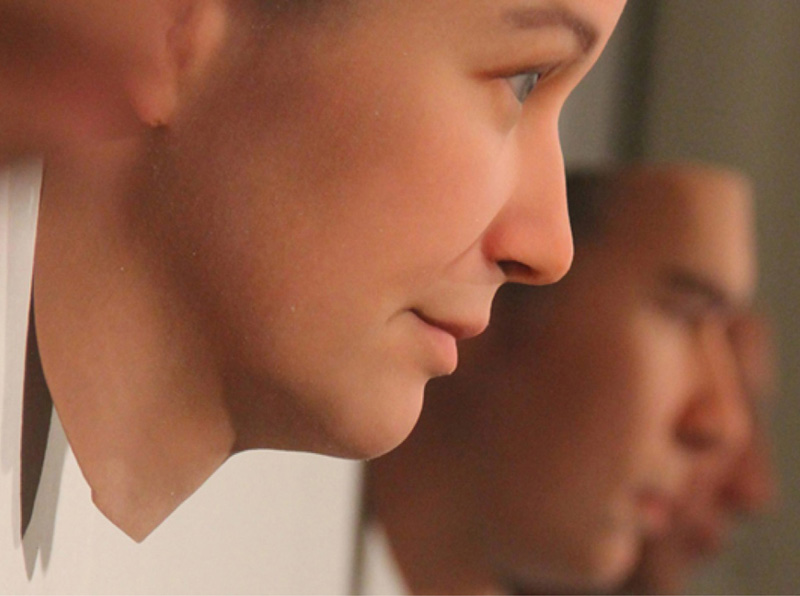Face Generator

8. Although Matthias Dörfelt's Weird Faces (2012) look hand-drawn, they are entirely generated by custom software.
Brief
Write code to design an image of a face that is parameterized by at least three dimensions of variability, but preferably more. For example, you might have variables that specify the size, position, color, or other visual characteristics of the eyes, nose, and mouth. The variations in these features may be used to alter the face's expression (happy, sad, angry); the face's identity (John, Maria); and/or the face's species (cat, monkey, zombie, alien). Give special consideration to controlling the precise shape of face parts, such as the curves of the nose, chin, ears, and jowls, as well as characteristics like skin color, stubble, hairstyle, blemishes, interpupillary distance, facial asymmetry, cephalic index, and prognathism. Differentiate continuous parameters (such as size and position of features) and discrete parameters (such as the presence of piercings, or the number of eyeballs). Will your faces be 2D or 3D? Will they be shown in a frontal, profile, or three-quarters view? Your system should generate a new face whenever the user presses a button.
Learning Objectives
- Design parametric forms using drawing functions and the Cartesian coordinate system
- Apply generative design principles to expressive character design
- Conduct meta-design (design a system to design things)
Variations
- Use your software to generate a deck of collectible trading cards (like Pokémon or baseball cards) featuring a group of imaginary heroes or monsters. Print out the cards.
- Try using real-world multivariate data as the basis for generating new faces, instead of randomness.
- Create an interactive tool that allows people to make self-portraits in a cartoon style. Document your software with an example.
- Consider the comparative merits of a design in which faces are assembled from a diverse collection of ready-made assets (mustaches, noses, etc.), versus a design in which faces are generated from continuously variable curves and shapes.
- Add functionality to your face so that it responds to audio, microphone, or speech input.
Making It Meaningful
Humans are equipped with an exquisite sensitivity to faces. From infancy, we easily recognize faces and can detect very subtle shifts in expressions, often being able to discern the slightest change in mood and sincerity in ways that remain impossible for computers. Faces also allow us to readily identify family resemblances or recognize friends in crowds. Faces are so central to visual perception that “the impairment of our face-processing ability is seen as a disorder, called prosopagnosia, while unconsciously seeing faces where there are none is an almost universal kind of pareidolia.” i
This assignment draws inspiration from the “Chernoff face” data visualization technique, which leverages this sensitivity by using facial features to represent multivariate data. In Chernoff faces, features such as the eyes, ears, mouth, and nose represent data according to their shape, size, placement, and orientation. Whereas Herman Chernoff used 18 variables to synthesize a face, Paul Ekman and Wallace Friesen's Facial Action Coding System analyzes faces with 46, each variable corresponding to the action of a different facial muscle.
Works that generate faces present the conceptual opportunity to devise a possibility space or an imaginative context for portraits—like a family album, high school yearbook, or tradeable card deck.

9. In Heather Dewey-Hagborg's astounding Stranger Visions (2012), forensic 3D portraits are computed from found DNA fragments.

10. “Chernoff faces” (1973) represent multivariate data by parameterizing the shape, size, position, and orientation of the parts of the face.

11. In Kate Compton's software Evolving Faces with User Input (2009), a genetic algorithm governs a population of faces, each described with an array of floating point numbers. By selecting a favorite face, the user can interactively guide the evolution of the population.

12. In Mike Pelletier's Parametric Expression (2013), values that govern the articulation of facial models are pushed beyond their normal limits.

13. In Karolina Sobecka's All the Universe Is Full of the Lives of Perfect Creatures (2012), the visitor puppeteers an avatar according to the movements of their own face.

14. Prescribed to Death is a wall memorial comprised of 22,000 pills carved with human faces, representing Americans who died from opioid addiction in 2017. Every 24 minutes—the frequency of U.S. opioid deaths—a Rhino Grasshopper script directs an onsite CNC machine to carve a new face into an additional pill. The project was developed for the National Safety Council's “Stop Everyday Killers” campaign by artist collective Hyphen-Labs, Energy BBDO, MssngPeces, and Tucker Walsh.
Additional Projects
- Zach Blas, Facial Weaponization Suite, 2011–2014, masks computationally modeled from aggregate face data.
- Lorenzo Bravi, Bla Bla Bla, 2010, sound- reactive phone application.
- Joy Buolamwini, Aspire Mirror, 2015, mirror and generative face system.
- Heather Dewey-Hagborg, How Do You See Me, 2019, self portraits generated via adversarial processes.
- Adam Harvey and Jules LaPlace, Megapixels, 2017, art and research project.
- Hyphen-Labs and Adam Harvey, HyperFace, 2017, computer vision camouflage textile.
- Mario Klingemann, Memories of Passersby I, 2018, system for synthesizing portraits using neural nets.
- Golan Levin and Zachary Lieberman, Reface [Portrait Sequencer], 2007, system for generating face composites.
- Jillian Mayer, IMPRESSIONS, 2017, facial analysis and billboard campaign.
- Macawnivore, Nose Chart, 2014, digital drawing.
- Kyle McDonald and Arturo Castro, Face Substitution, 2012, face-swapping application and installation.
- Orlan, The Reincarnation of Saint ORLAN, 1990–1993, facial surgery as performance.
- Ken Perlin, FaceDemo, 1997, interactive face simulation.
Readings
- Greg Borenstein, “Machine Pareidolia: Hello Little Fella Meets Facetracker, Idea for Dozens (blog), UrbanHonking.com, January 14, 2012.
- Charles Darwin, The Expression of Emotions in Man and Animals (London: John Murray, 1872).
- Heather Dewey-Hagborg, “Sci-Fi Crime Drama with a Strong Black Lead,” The New Inquiry, July 16, 2015.
- Paul Ekman and Wallace Friesen, Facial Action Coding System (FACS), 1976.
- Zachary Lieberman, “Más Que la Cara Overview,” Medium.com, April 3, 2017.
- Bruno Munari, Design as Art (London: Penguin Books Ltd., 1971).
- Jean Robert and Francois Robert, Face to Face (Zurich: Lars Muller Publishers, 1996).
- George Tscherny, Changing Faces (New York: Princeton Architectural Press, 2004).